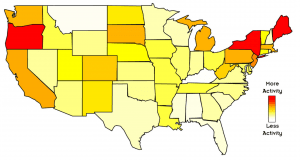MD Conover, C Davis, E Ferrara, K McKelvey, F Menczer, and A Flammini.
PLoS One 8(3):e55957 (2013).
Useful links: PDF | Journal page.
Social movements rely in large measure on networked communication technologies to organize and disseminate information relating to the movements’ objectives.
In this work we seek to understand how the goals and needs of a protest movement are reflected in the geographic patterns of its communication network, and how these patterns differ from those of stable political communication. To this end, we examine an online communication network reconstructed from over 600,000 tweets from a thirty-six week period covering the birth and maturation of the American anticapitalist movement, Occupy Wall Street.
We find that, compared to a network of stable domestic political communication, the Occupy Wall Street network exhibits higher levels of locality and a hub and spoke structure, in which the majority of non-local attention is allocated to high-profile locations such as New York, California, and Washington D.C. Moreover, we observe that information flows across state boundaries are more likely to contain framing language and references to the media, while communication among individuals in the same state is more likely to reference protest action and specific places and times.
Tying these results to social movement theory, we propose that these features reflect the movement’s efforts to mobilize resources at the local level and to develop narrative frames that reinforce collective purpose at the national level.

